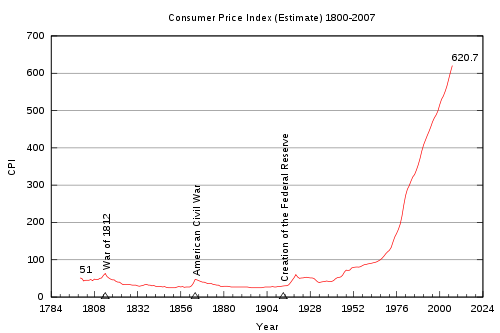Gold standard (economics)
Post on: 2 Сентябрь, 2015 No Comment

—Every crazy old prospector ever
The gold standard (in economics ) refers to a type of monetary system where the currency of a country is backed directly by the national gold reserves. In theory, it is possible for anyone to go to a bank and exchange a sum of money for a specific amount of gold.
[edit ] History
[edit ] Ancient to early modern history
In ancient, medieval, and early modern monetary systems, coins were manufactured from gold, silver and other metals because of its ability to be mass produced and standardized. Because gold and silver were only owned by the wealthy for many centuries, people developed a fetishized desire for the metals and believed them to have a power over others, giving them an intrinsic value in themselves (i.e. the coins were specie ). Before the first millennium BCE, most economic transactions were based on credit arrangements in which resources were exchanged as gifts, with the expectation that the gift would be paid back with interest at a later date. Rare metals were kept by the temples in ingot form and used as a form of accounting, and were not used in transactions until the early iron ages. During the Axial Age (800 — 200 BCE), large scale warfare broke out among different competing states and kingdoms, fought by free peasant soldiers who plundered cities and removed stashes of gold and silver from temple stores, thus allowing the metals to be distributed among them. The first gold coins were minted in Lydia (located in modern-day Turkey ) in the 500s BCE to pay the salaries of its soldiers. This form of coinage became the prototype for other ancient currencies used in places such as Persia. Babylonia. and the Greek empire. [1] States also mandated that taxes and fees must be paid in coin, making bullion widespread for the first time. Gold coinage in China was also produced during this same period, and legends say that coinage was created by the emperor to deal with a flood crisis that created a famine. [2] The gold coins minted by the emperor Constantine (the solidus ) were used widely throughout the Mediterranean and remained the currency of the Byzantine Empire until its fall. [3] During the Middle Ages, silver coinage became more popular as the Byzantine Empire declined and eventually collapsed. [4] By the 18th century, keeping coins themselves as a store of value became impractical. Increasing quantities of money in circulation, growing use of notes and bank credit, and declining resources of silver during this period were factors that led to the development of the gold standard.
[edit ] Formalization of the gold standard in modern history
The first country to formally adopt the gold standard was Great Britain. The gold standard was formalized over the period of the late 17th century to the early 19th century. The British government debased its bimetallic currency toward the end of the 17th century in order to pay off debt run up during the Nine Years’ War. Much of the silver coinage in circulation at this point had been clipped and counterfeiting began to increase. These factors caused a monetary crisis that led to what was known as the The Great Recoinage of 1696. [5] The Bank of England, chartered in 1694 to provide credit to the British government, issued bank notes backed by and convertible to gold. The overabundance of credit in the form of paper currency in the late 18th century led to the suspension of the conversion of bank notes into gold from 1797-1821. Britain lifted this suspension in 1821 and returned to a formal gold standard. Other nations followed suit soon after, leading to the creation of an international gold standard. [6] The gold standard was suspended again during World War I and then reinstated, though war debts and other economic difficulties put massive amounts of pressure on the international gold standard system during the interwar period. [7]
[edit ] The Great Depression to Bretton Woods
The Great Depression marked the collapse of the formal gold standard internationally. As Britain was the first to adopt the gold standard, it was also the first to leave the gold standard, doing so in 1931. The US left the gold standard in 1933, withdrew gold from circulation for everyday transactions, and devalued the dollar. [8] Many other nations followed and abandoned the gold standard.

The U.S. didn’t completely abandon the gold standard during the Great Depression, though. Although private ownership of bullion gold was illegal, the price of gold was still pegged at $35 per ounce by law.
After World War II. a new international monetary system was developed known as Bretton Woods, envisioned by John Maynard Keynes and Harry Dexter White. Under the Bretton Woods agreement, the US was on a quasi-gold standard. Holding about 75% of the world’s monetary gold supply allowed the US to back the dollar with gold on the foreign exchange market and honor international trade debts in gold. Other nations agreed to peg their currencies to the dollar. As the world market price of gold increased, U.S. gold stocks were undervalued at its officially peg price of $35 per ounce (later $42). This hampered the U.S. government’s ability to collateralize debt and take full advantage of the real value of its gold stockpiles.
In what became known as the Nixon Shock, the system of fixed exchange rates lasted until 1971 when Richard Nixon closed the gold window and the Bretton Woods system came to an end. [6] [9] The US dollar was already falling against the world gold price and since world markets were abandoning fixed currency exchange rates, no one would invest in the US without a substantial increase in interest rates. Nixon felt that allowing the gold price to inflate in line with world prices was less politically risky than doubling interest rates.














